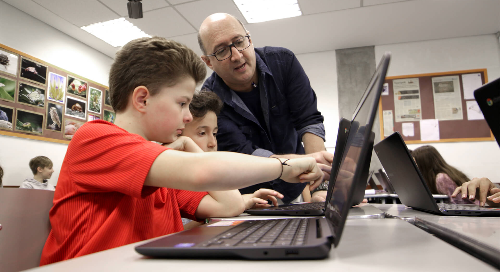
We know students may be entering this school year with increased anxiety, and assessment can be an added stress-point. That’s a reality that most of us can relate to: maybe you've tried to help your child prepare and relax the night before a big exam, or perhaps you've been the one sitting at a classroom desk anxiously waiting for a test to begin. Nonetheless, assessment plays a critical role in helping educators understand where each student is academically and if any learning gaps need to be addressed. So how do we as educators shift students' perception of assessments from something negative to a positive part of their learning journey? Here are five ways:
1. Change how you approach assessment
The best way to help students stressed by assessment is for teachers to fundamentally change how they use assessments. Assessments become stressful when we emphasize how the results will impact a student’s grade rather than focusing on the opportunity to help students learn. All too often, teachers and students view assessments as the finish line, the culmination of a unit or even a school year.
Instead, assessments should serve as a starting place to better understand the needs of students and be used throughout the learning process to continuously gauge students’ understanding. This is the fundamental difference between summative assessment—assessment of learning—and formative assessment, or assessment for learning. In a recent survey by Instructure, only 29% of parents and teachers felt high-stakes testing was an important measurement of student learning.
2. Embrace change: shift the teacher mindset
Changing to a formative mindset requires teachers to rethink their assessment and grading practices completely. If you think back to when you were in school, a test usually represented your last chance to demonstrate understanding of what you were expected to learn. If you did poorly, that was it; you missed your opportunity to learn, your grade suffered, and the teacher moved on to the next concept or chapter in the book. This practice creates stress and unknowable anxiety for students.
Teachers who adopt a formative approach use assessment data to identify student levels of understanding so that they can provide immediate support to students through remediation or intervention. The grade is secondary to meeting the individual needs of a student. In that same survey by Instructure, we found that 76% of educators delivered formative assessments or assessments for learning, to check students’ understanding during remote learning.
Importantly, teachers also use formative assessment data to evaluate their own instructional efficacy. When assessment becomes a means of improving teaching and learning outcomes, we eliminate the stress and anxiety from assessments for students.
3. Lead by example: shift the administrative mindset
If we expect teachers to change how they assess and grade students, the shift in mindset has to start with district and school leaders. It’s important that administrators embrace formative assessment and lead in the transition by seeking effective, reliable assessments that provide teachers with actionable data in the moment.
Additionally, school leaders should partner with teachers in creating consistent assessment strategies and grading frameworks that help eliminate the uncertainty and stress students often feel as they transition from one class to another. Lastly, district leaders must provide teachers ongoing support by establishing professional learning communities and investing in meaningful professional development that supports the adoption of formative assessment practices.
4. Empower students: shift the learner mindset
Much of the stress students feel when they take an assessment is directly related to how the results will affect their grade. It’s important that students understand assessment doesn’t always mean grades and test scores. Instead, it's a way for them to demonstrate what they know and, perhaps more importantly, where they might need more help.
By reframing the value of assessments, we can help students shift their mindset from worrying about grades to focusing on learning. With that shift, we can create an environment where teachers use assessment data as a conversation starter with students and help them set academic goals and take on more responsibility for their learning.
5. Forge a partnership: shift parent mindset
It’s essential that educators remember to include parents in the conversation around assessment. Teachers often use formative assessments to give them an understanding of where students are at prior to or even during instruction. For parents who are new to the concept, the results on a pretest could cause concern. Take the time to explain to parents the purpose of an assessment, and how it will be used to accelerate their child’s learning.
It’s also not uncommon for parents to unknowingly—and with the best of intentions—contribute to student test anxiety. We all want our kids to perform well in school and our own experiences often lead us to reinforce the impact a test might have on their grades. Helping parents understand that the value of assessment is at its highest when it is being done formatively only helps to improve the process for everyone involved.
Interested in learning more about using assessments to help guide the learning process and positively impact student learning outcomes? Download the e-Book Key Strategies for Impactful Formative Assessment.
Related Content
 canvas-offline-blog-thumbnail-2024.jpg
canvas-offline-blog-thumbnail-2024.jpgBlog Articles
 3.png
3.pngBlog Articles
 googlexinst.png
googlexinst.pngBlog Articles
